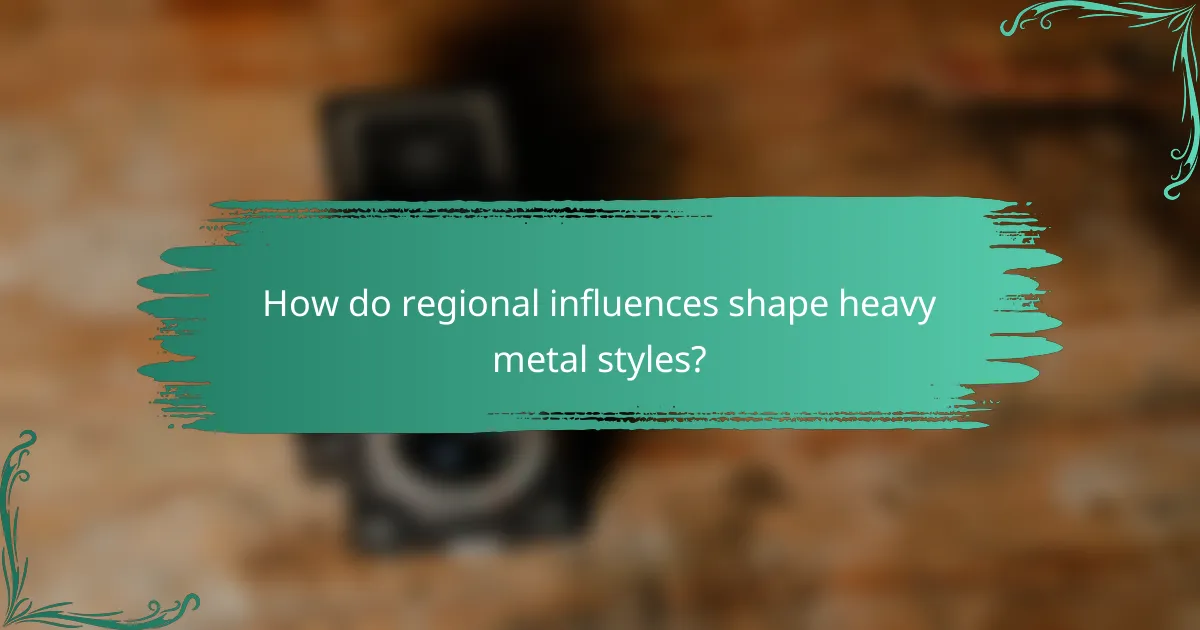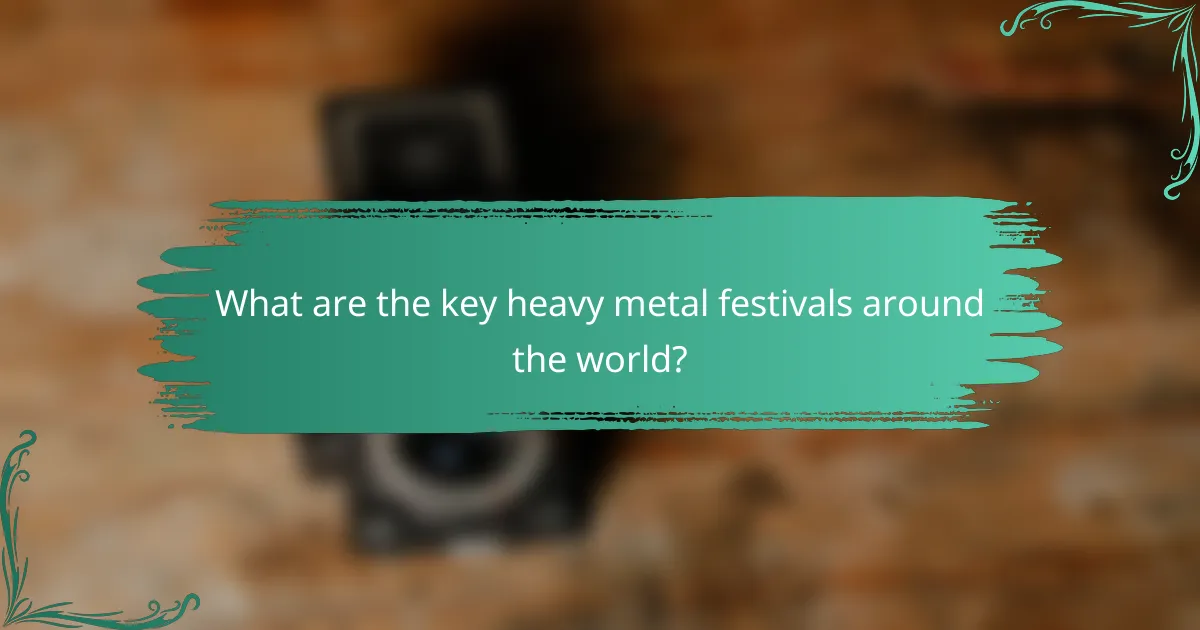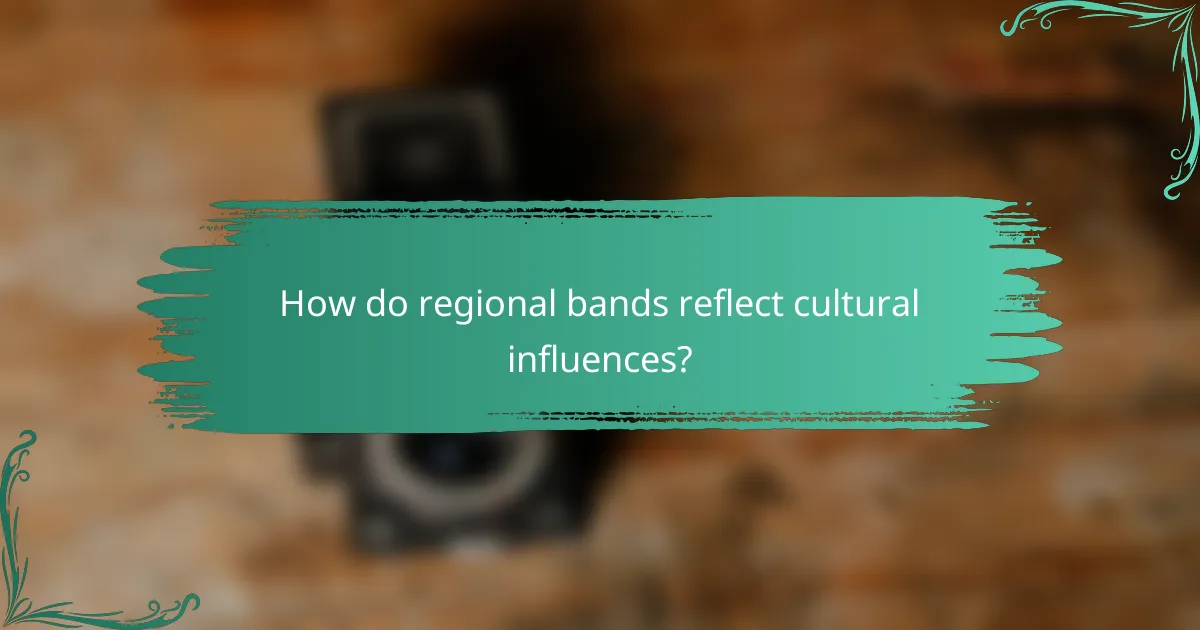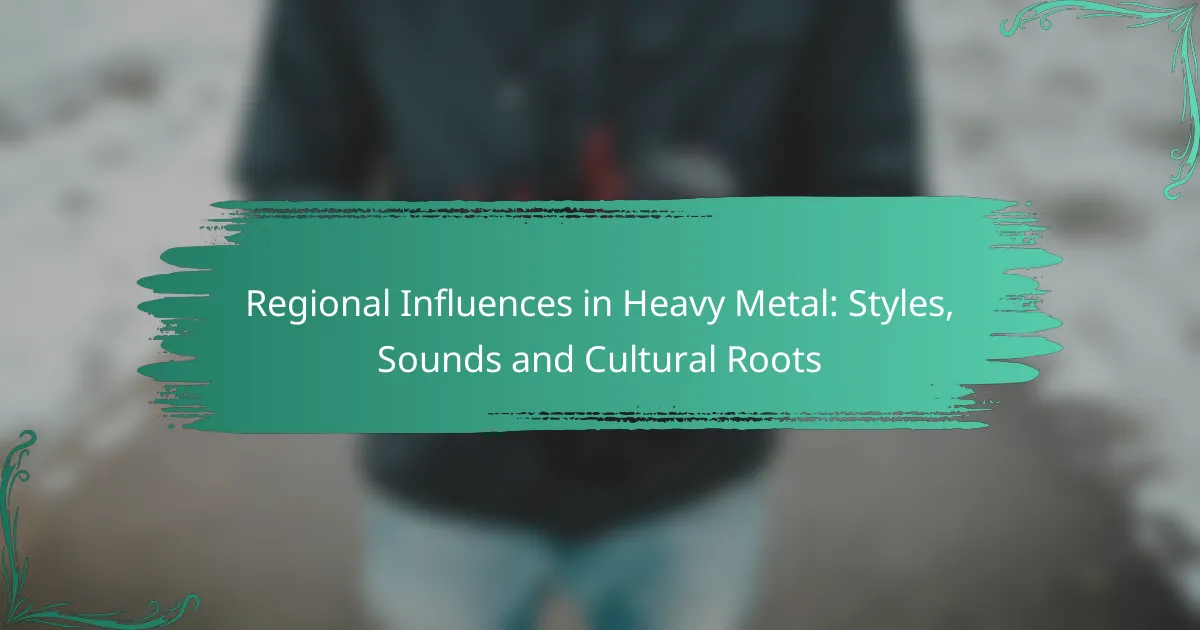Regional influences play a crucial role in shaping heavy metal, as local musical traditions and cultural narratives intertwine to create unique styles and sounds. These elements not only reflect the historical and social contexts of different areas but also contribute to the genre’s rich diversity and evolution. By incorporating regional characteristics into instrumentation and vocal styles, heavy metal resonates deeply with audiences worldwide, giving rise to distinct subgenres that celebrate cultural roots.

How do regional influences shape heavy metal styles?
Regional influences significantly shape heavy metal styles by incorporating local musical traditions, cultural narratives, and social issues. These elements create distinct sounds and themes that resonate with audiences in different parts of the world.
European heavy metal genres
Europe is home to a rich variety of heavy metal genres, including power metal, black metal, and folk metal. Each genre often reflects the cultural heritage of its origin, with power metal frequently drawing on fantasy themes and black metal embracing darker, atmospheric elements. Countries like Germany and Sweden have become notable hubs for these styles, contributing to a diverse metal landscape.
For example, bands like Helloween and Blind Guardian from Germany exemplify power metal’s melodic and theatrical aspects, while Norway’s Mayhem and Burzum are key figures in the black metal scene, known for their raw sound and philosophical themes.
North American heavy metal characteristics
North American heavy metal is characterized by its aggressive sound and diverse subgenres, including thrash, death, and nu-metal. Bands like Metallica and Slayer pioneered thrash metal in the 1980s, combining speed with complex riffs and socially conscious lyrics. This region often emphasizes technical proficiency and a heavier sound compared to European counterparts.
Additionally, the influence of punk rock in the U.S. has led to a more rebellious and raw approach in many North American metal bands, creating a distinct identity that resonates with fans seeking intensity and authenticity.
Asian heavy metal innovations
Asian heavy metal is marked by unique innovations that blend traditional music with contemporary metal sounds. Countries like Japan and India have produced bands that incorporate local instruments and scales, creating a fusion that stands out globally. For instance, Japanese bands like X Japan integrate classical music elements, while Indian metal often features traditional rhythms and instruments like the tabla.
This blending of styles not only showcases regional cultural heritage but also attracts a diverse audience, expanding the global reach of heavy metal.
Latin American metal scenes
Latin America boasts vibrant metal scenes that often reflect the region’s social and political issues. Genres like Latin metal and thrash have gained popularity, with bands such as Sepultura from Brazil and Los Moxos from Mexico addressing themes of identity and resistance. The music often incorporates local rhythms and languages, making it relatable to the audience.
Festivals like the Metal Fest in Chile highlight the growing community and diversity within Latin American metal, fostering collaboration among bands and fans alike.
African metal influences
African heavy metal is emerging as a powerful force, characterized by its incorporation of indigenous sounds and themes. Bands from countries like South Africa and Nigeria are blending traditional African music with heavy metal, creating a unique sound that resonates with local and international audiences. For example, the band Tumi and the Volume combines hip-hop and metal, reflecting contemporary social issues.
This fusion not only showcases the continent’s rich musical heritage but also challenges stereotypes, proving that heavy metal can thrive in diverse cultural contexts.

What are the cultural roots of heavy metal in different regions?
The cultural roots of heavy metal vary significantly across regions, influenced by historical, social, and political contexts. Each area contributes unique sounds and themes that shape the genre’s evolution and identity.
Historical context in the UK
The UK is often regarded as the birthplace of heavy metal, with bands like Black Sabbath and Led Zeppelin emerging in the late 1960s and early 1970s. This period was marked by a post-war sentiment, where industrial decline and social upheaval inspired darker themes in music.
British heavy metal drew on blues and rock traditions, infusing them with a heavier sound and theatrical elements. The genre’s roots in working-class struggles and rebellion against authority resonate in the lyrics and performances of many UK bands.
Social movements in the US
In the US, heavy metal evolved alongside various social movements, including counterculture and youth rebellion during the 1960s and 1970s. Bands like Metallica and Slayer emerged from the thrash metal scene, reflecting the angst and disillusionment of a generation.
The genre often addresses themes of personal freedom, anti-establishment sentiments, and social issues, resonating with fans who identify with these struggles. The DIY ethic of underground scenes also played a crucial role in shaping the sound and culture of American heavy metal.
Folklore and mythology in Scandinavia
Scandinavian heavy metal frequently draws inspiration from local folklore and mythology, with bands like Amon Amarth and Finntroll incorporating Viking themes and Norse legends into their music. This connection to cultural heritage adds depth and authenticity to the genre.
The use of traditional instruments and melodies alongside heavy riffs creates a unique sound that reflects the region’s history and landscapes. This blending of ancient tales with modern metal resonates with audiences seeking a connection to their roots.
Political influences in South America
In South America, heavy metal often serves as a platform for political expression, addressing issues such as corruption, inequality, and social injustice. Bands like Sepultura and Angra have used their music to challenge the status quo and raise awareness about local struggles.
The genre’s raw energy and aggressive sound resonate with audiences facing political turmoil, making it a powerful tool for activism. Festivals and underground scenes in countries like Brazil and Argentina showcase the vibrant metal culture that thrives despite challenges.

How do local sounds impact heavy metal music?
Local sounds significantly shape heavy metal music by infusing regional characteristics into its instrumentation, vocal styles, and production techniques. These influences create distinct subgenres that reflect the cultural roots and musical traditions of different areas.
Instrumentation variations by region
Instrumentation in heavy metal varies widely across regions, often incorporating local musical elements. For example, Scandinavian metal frequently features keyboards and orchestral arrangements, while Latin American metal might include traditional instruments like the charango or marimba, adding unique textures to the sound.
In the United States, the use of downtuned guitars and heavy distortion is prevalent, particularly in subgenres like sludge and doom metal. In contrast, Japanese metal often emphasizes technical precision and melodic elements, showcasing a blend of Western metal with traditional Japanese music.
Vocal styles in different cultures
Vocal styles in heavy metal differ significantly based on cultural influences. For instance, European metal often showcases operatic vocals, especially in symphonic and power metal, while American metal tends to favor aggressive styles, including growls and screams.
In regions like Brazil, vocalists may incorporate samba rhythms and melodies, creating a fusion that distinguishes their sound. Similarly, Middle Eastern metal bands often utilize traditional scales and vocal techniques, enriching the genre with diverse cultural expressions.
Production techniques unique to regions
Production techniques in heavy metal can vary based on regional practices and available technology. For example, European metal often emphasizes a polished sound with high production values, utilizing advanced studio techniques to achieve clarity and depth.
Conversely, some underground scenes, such as those in Eastern Europe, may favor a rawer sound, reflecting the DIY ethos of local bands. This approach can lead to a more authentic feel, resonating with fans who appreciate the unrefined aspects of the genre.

What are the key heavy metal festivals around the world?
Key heavy metal festivals around the world showcase a diverse range of styles and sounds, attracting fans and bands alike. These events often highlight regional influences and cultural roots, making them significant in the heavy metal community.
Wacken Open Air in Germany
Wacken Open Air, held annually in Wacken, Germany, is one of the largest and most renowned heavy metal festivals globally. It typically features over 150 bands across multiple stages, drawing crowds of around 75,000 attendees each year.
The festival is known for its diverse lineup, including established legends and emerging acts, making it a must-visit for metal enthusiasts. Attendees can enjoy a range of activities beyond music, such as metal markets and signing sessions with artists.
Download Festival in the UK
Download Festival, located in Donington Park, UK, is another major heavy metal event, usually attracting around 100,000 fans. It features a mix of classic rock and metal bands, offering a platform for both iconic and up-and-coming artists.
The festival spans three days and includes various stages, allowing for a rich variety of performances. Download is also known for its vibrant atmosphere, with camping options and numerous food and merchandise stalls enhancing the overall experience.
Coachella’s metal acts in the US
While primarily known for its diverse music lineup, Coachella in California also features notable metal acts, showcasing the genre’s crossover appeal. The festival attracts a wide audience, with ticket sales often exceeding 100,000 per weekend.
Metal bands at Coachella benefit from exposure to a broader audience, which can lead to increased popularity and fan engagement. The festival’s unique setting and cultural significance provide a distinct experience for metal fans.
Hellfest in France
Hellfest, held in Clisson, France, is a premier heavy metal festival that typically attracts around 60,000 attendees. Known for its extensive lineup, Hellfest features a mix of genres, including doom, black, and thrash metal, making it a favorite among hardcore fans.
The festival spans three days and includes multiple stages, allowing for a wide range of performances. Hellfest also emphasizes the community aspect of metal culture, with various activities and merchandise options that celebrate the genre’s rich history.

How do regional bands reflect cultural influences?
Regional bands reflect cultural influences through their music, lyrics, and performance styles, which often incorporate local traditions, languages, and social issues. These elements create a unique sound that resonates with their audience and showcases their cultural identity.
Iron Maiden’s British heritage
Iron Maiden embodies British heritage by integrating themes from British history, literature, and folklore into their music. Songs like “The Trooper” draw on historical events, while their artwork often features iconic British symbols, enhancing their connection to the UK.
The band’s sound is characterized by melodic guitar riffs and complex song structures, which reflect the progressive rock influences prevalent in Britain during the 1970s. This distinct style has made them a cornerstone of the New Wave of British Heavy Metal (NWOBHM) movement.
Sepultura’s Brazilian roots
Sepultura showcases Brazilian roots by blending traditional Brazilian music elements with heavy metal. Their incorporation of rhythms from samba and other local styles creates a unique sound that distinguishes them from their peers in the genre.
The band’s lyrics often address social and political issues relevant to Brazil, such as poverty and inequality, allowing them to resonate deeply with their local audience. Albums like “Roots” exemplify this fusion, featuring indigenous instruments and themes that highlight their cultural background.
Babymetal’s fusion of J-Pop and metal
Babymetal represents a fusion of J-Pop and metal, creating a distinctive genre known as kawaii metal. This blend combines the upbeat, catchy melodies of J-Pop with heavy metal instrumentation, resulting in a sound that appeals to a diverse audience.
Their performances are characterized by choreographed dance routines and vibrant visuals, which reflect Japanese pop culture. This unique combination has garnered international attention, showcasing how regional influences can create innovative musical styles that transcend cultural boundaries.
